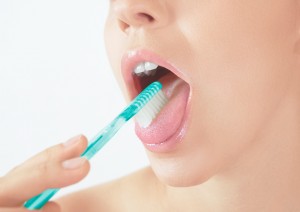 On any given day, you might be hosting approximately 20 billion bacteria inside your mouth. Yikes! But don’t worry. Many of those are good bacteria that keep you healthy, and having a certain mixture of mouth and tongue bacteria is a good thing. However, if the bad bacteria build up, this can at the very least cause bad breath, and it might also lead to gum disease and other serious issues. According to Scientific American, a whopping 25 percent of the world’s population has chronic bad breath, which indicates a bacterial problem. It isn’t enough just to keep your teeth clean and rinse your mouth with mouthwash. You need to (gently) scrape or brush your tongue to effectively remove that nasty bacteria.
On any given day, you might be hosting approximately 20 billion bacteria inside your mouth. Yikes! But don’t worry. Many of those are good bacteria that keep you healthy, and having a certain mixture of mouth and tongue bacteria is a good thing. However, if the bad bacteria build up, this can at the very least cause bad breath, and it might also lead to gum disease and other serious issues. According to Scientific American, a whopping 25 percent of the world’s population has chronic bad breath, which indicates a bacterial problem. It isn’t enough just to keep your teeth clean and rinse your mouth with mouthwash. You need to (gently) scrape or brush your tongue to effectively remove that nasty bacteria.
The Importance of Brushing or Scraping Your Tongue
Oral ecology is a field unto itself, and there may be ways to adjust the bacteria in your mouth for a healthier balance. But what can you do now if you have bad breath or a white coated tongue? The ideal tongue color is a uniform pink. If there is a white film (or brown film) on the top, that indicates a combination of bacteria, food debris and dead cells. Fortunately, properly cleaning your tongue can bring back your tongue’s natural healthy coloring, in addition to eliminating bad breath and minimizing other oral health problems. There are various tools you can use, from a soft toothbrush to a specially designed tongue cleaner, tongue brush or tongue scraper.
What Should I Use to Clean My Tongue?
The type of tool you use to clean your tongue is less important than to make sure you’re doing it daily, as part of your dental hygiene. What’s most important is that you are gentle, so that you don’t irritate or damage the tongue. It is also recommended that you brush from the back to the front. The back of the tongue is where the most bacteria will build up, since the back part receives less stimulation during the day than the front. Go as far back as you can comfortably go without gagging. Animated-Teeth.com provides a comprehensive guide to proper tongue cleaning. Brushing rather than scraping may be more effective for thorough cleaning in the tongue’s furrows and grooves, and in getting at the bacteria below the surface.
Rinse Your Mouth for Fresh Taste and Breath
After you brush or scrape your tongue, it’s important to finish it off by swishing around some mouthwash. This will rinse out the bacteria and debris, and will leave you with a clean, fresh mouth and sweet-smelling breath. You can use a commercial mouthwash, or if you prefer something more natural, there are effective plant-based products available. You can even make your own mouthwash from ingredients such as baking soda, tea tree oil and peppermint oil. Tea tree and peppermint oil have antibacterial and antifungal properties, while baking soda prevents fungus from growing. Other popular antibacterial ingredients include coconut oil, sea salt, eucalyptus, aloe vera and myrrh.







Leave a Reply